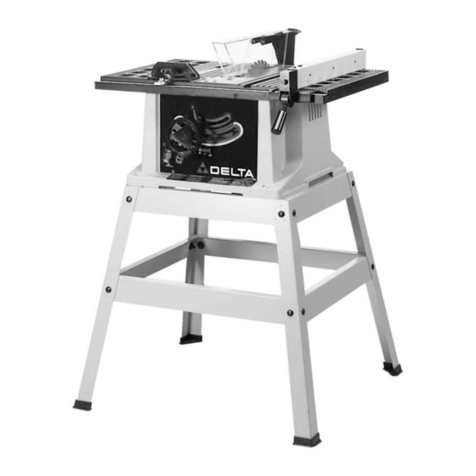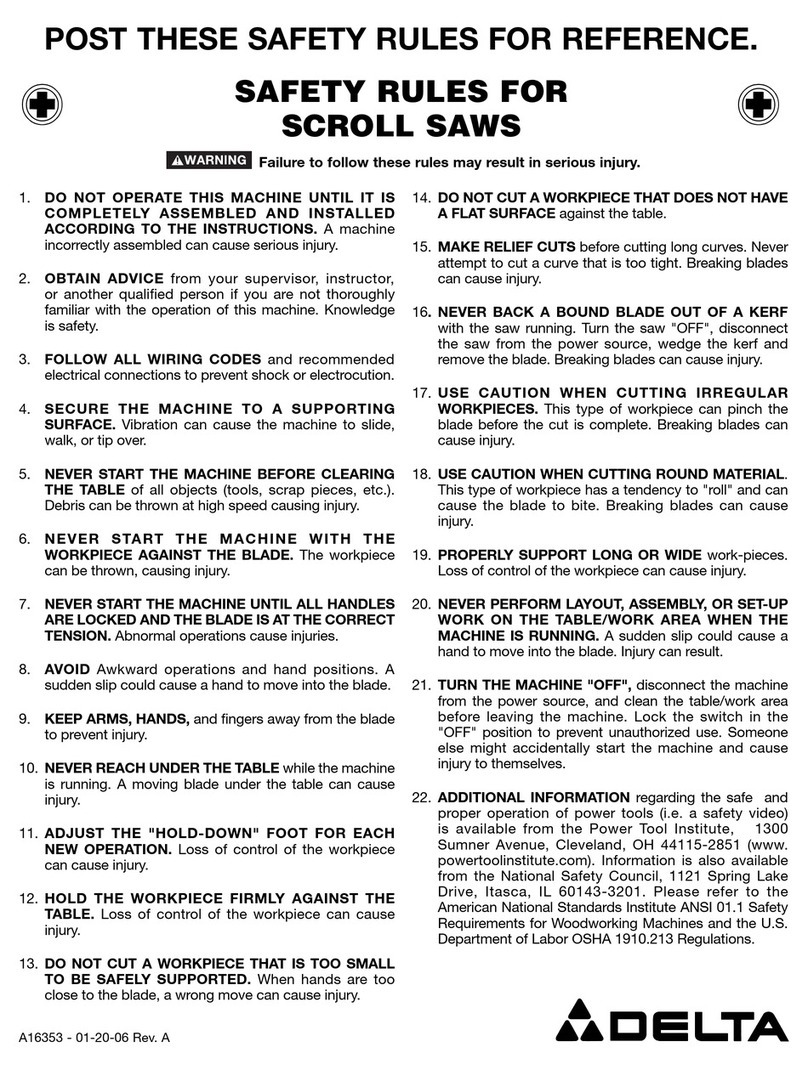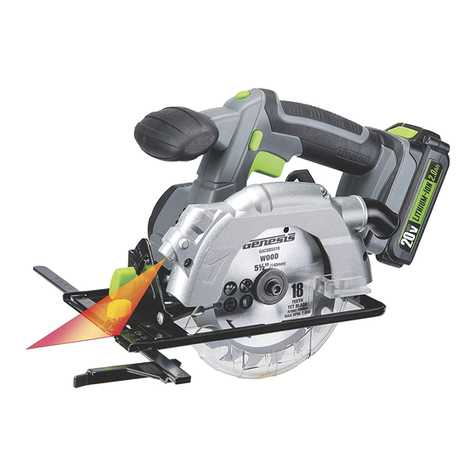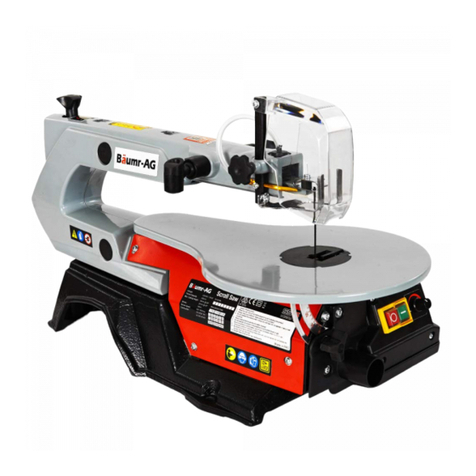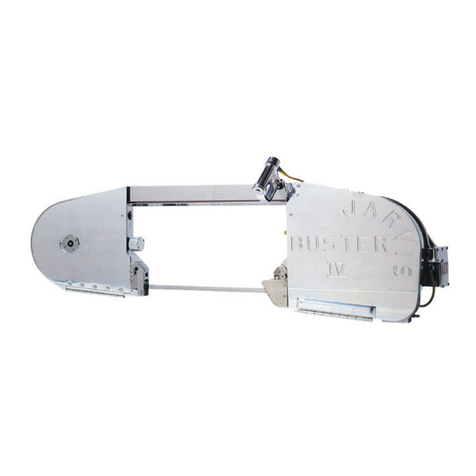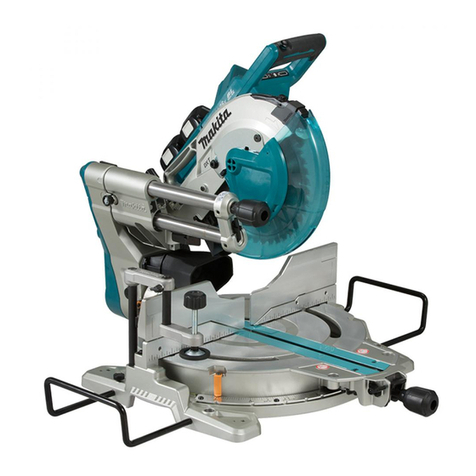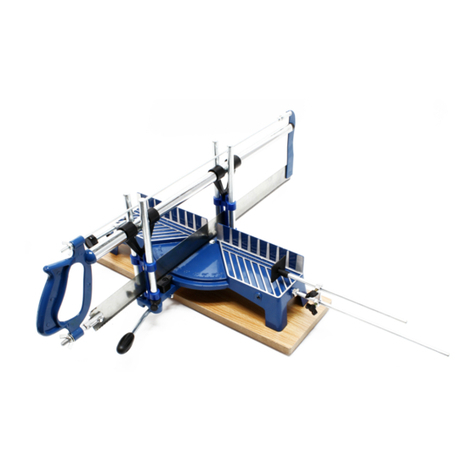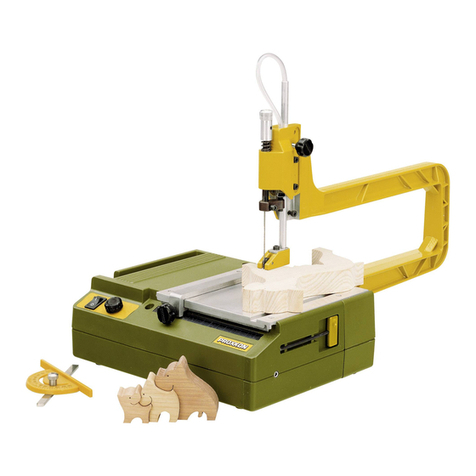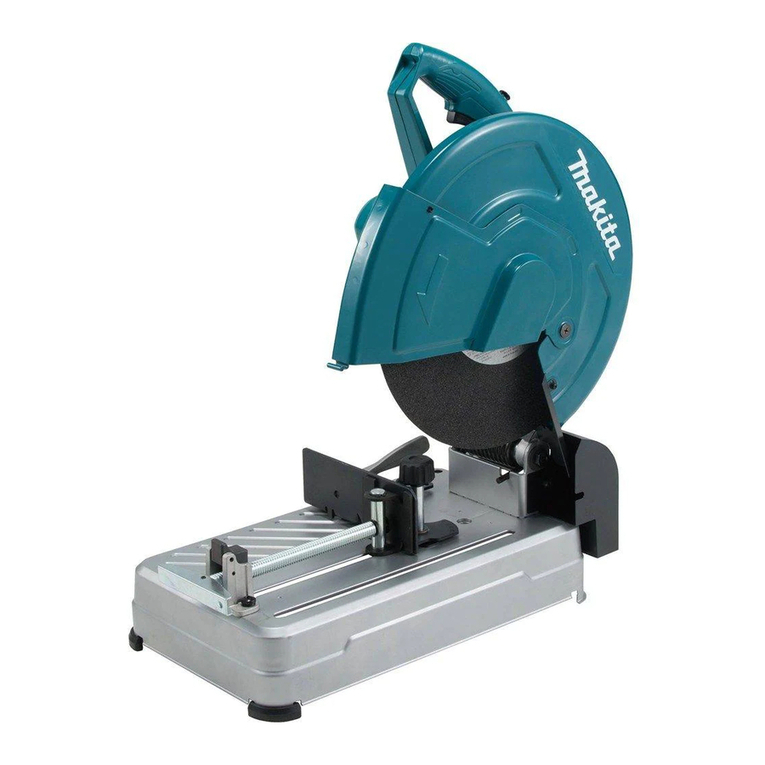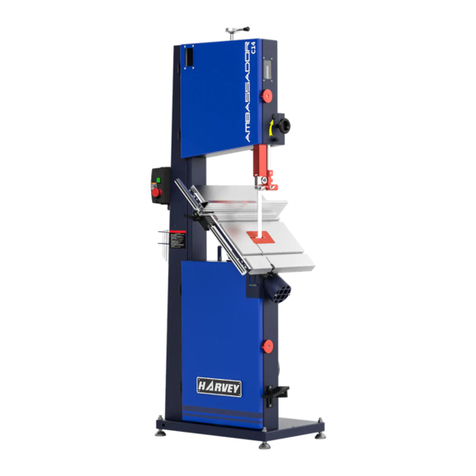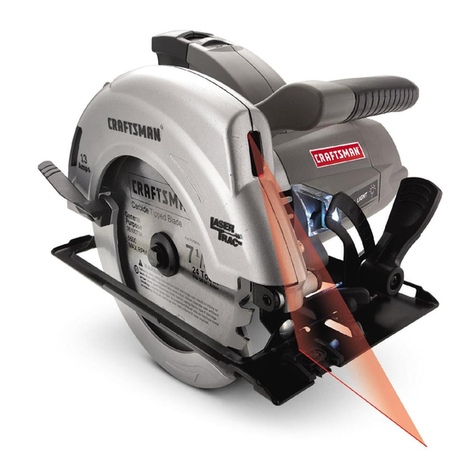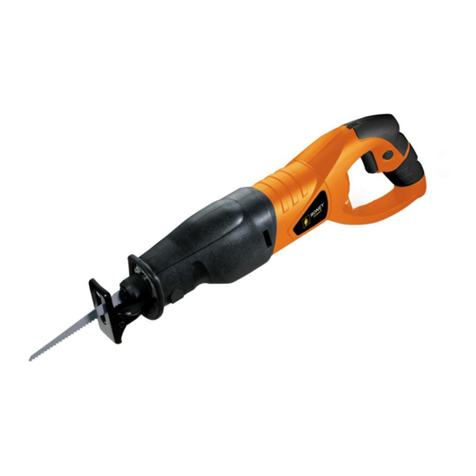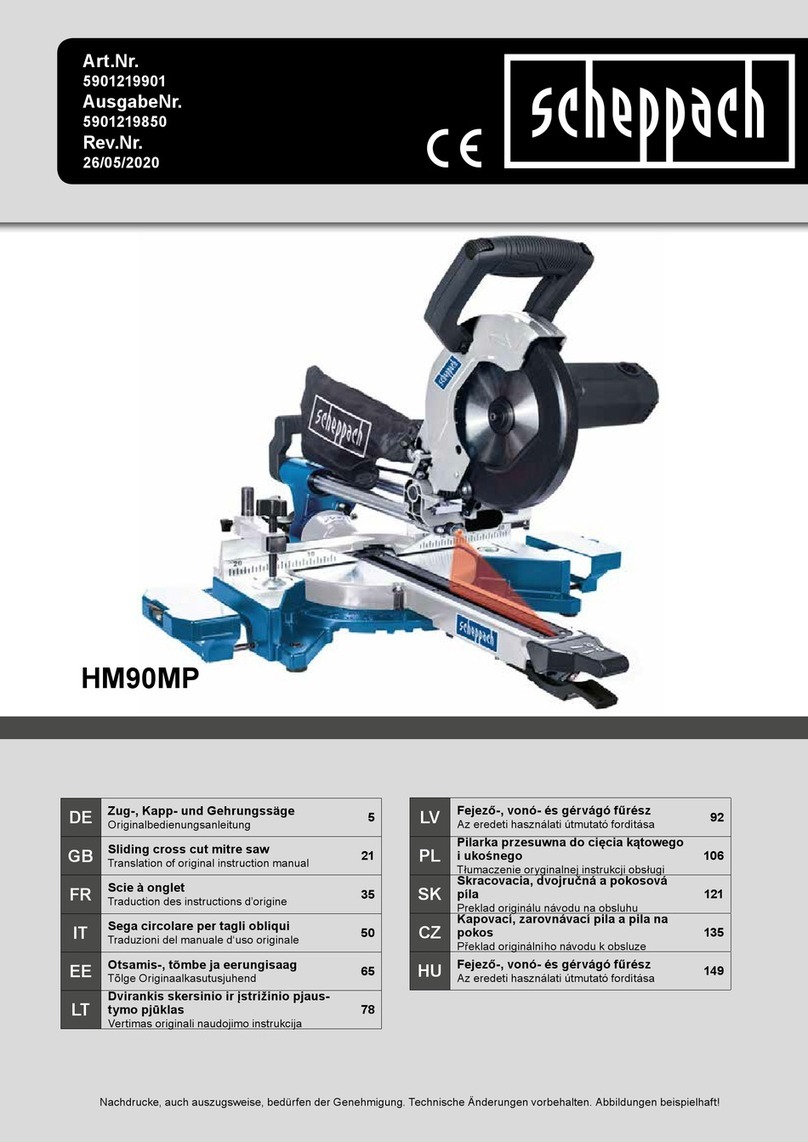Delta HOMECRAFT H26-260L User manual

H26-260L
Sierra ingletadora
compuesta
de 10 pulgadas
SCIE A ONGLET COMBINE
254 mm
Instruction Manual
Manuel d’utilisation
Manual de instrucciones
Français (25)
Español (49)
www.DeltaMachinery.com
To reduce risk of serious injury, thoroughly read and comply with all warnings and instructions inthis manual and on product.
KEEP THIS MANUAL NEAR YOUR SAW FOR EASY REFERENCE AND TO INSTRUCT OTHERS
10-IncH compound mIter Saw
1234567

TABLE OF CONTENTS
IMPORTANT SAFETYINSTRUCTIONS...................................2
safety logos.........................................................................3
GENERAL POWER TOOLSAFETY RULES ............................ 3
MITER SAW SAFETY RULES...................................................4
POWER CONNECTIONS ..........................................................5
Double Insulation................................................................5
Electrical Connection.........................................................6
Extension Cords .................................................................6
FEATURES ................................................................................6
Product Specifications.......................................................6
Know Your Compound Miter Saw.....................................7
UNPACKING AND ASSEMBLY ................................................8
ASSEMBLY.................................................................................9
Mounting the Saw to a Stable Surface ...........................10
Attach Horizontal Work Clamp........................................10
Install Dust Collection Bag ..............................................11
Install Batteries for Laser.................................................11
PREPARING YOUR SAW FOR USE.......................................12
Install/Replace the Blade.................................................12
Square the Blade to the Fence........................................13
Align the Blade to the Table.............................................14
Align the Laser Guide.......................................................15
To Remove Your Mark ..............................................15
To Cuton Your Mark.................................................15
To Cut without Removing Your Mark....................... 15
OPERATION.............................................................................16
Applications......................................................................16
Cross Cuts ........................................................................17
Bevel Cuts.........................................................................17
CompoundMiter Cuts......................................................17
TIPS FOR CUTTING AND SUPPORTING WORKPIECES....18
Tips for Cutting Crown Molding ......................................18
Cutting WarpedMaterial..................................................19
Clamping Wide Workpieces ............................................19
Supporting Long Workpieces..........................................20
ADJUSTMENTS.......................................................................20
Arm Pivot...........................................................................20
Positive Stop Screw.........................................................20
Bevel Pivot .......................................................................21
Depth Stop........................................................................21
Laser Guide.......................................................................21
MAINTENANCE ......................................................................22
KeepMachine Clean........................................................22
General Maintenance .......................................................22
Lubrication........................................................................22
Brush Replacement..........................................................22
TROUBLESHOOTING .............................................................23
Failure to Start ..................................................................23
ACCESSORIES ........................................................................23
PARTS, SERVICES AND WARRANTY ASSISTANCE...........23
THREE-YEAR LIMITED WARRANTY ....................................23
REPLACEMENT PARTS..........................................................24
SERVICE AND REPAIRS.........................................................24
IMPORTANT SAFETY INSTRUCTIONS
CAREFULLY READ AND FOLLOW ALL WARNINGS AND INSTRUCTIONS ON YOUR
PRODUCT AND IN THIS MANUAL. SAVE THIS MANUAL. MAKE SURE ALL USERS ARE FAMILIAR
WITH ITS WARNING AND INSTRUCTIONS WHEN USING THE TOOL. Improper operation, maintenance or
modification of tools or equipment could result inserious injury and/or property damage.
If you have any questions or concerns relative to the use of your tool or the contents of this manual, stop using the
tool andcontact DELTA® Power Equipment Corporation Customer Care at 1-800-223-7278.
SAFETY LOGOS
The definitions below describe the level of severity for each signal word. Please read the manual and pay attention to
these symbols.
Indicates an imminently hazardous situation which, if not avoided, will result in death or serious
injury.
Indicates a potentially hazardous situation which, if not avoided, could result in death or serious
injury.
Indicates a potentially hazardous situation which, if not avoided, may result in minor or moderate
injury.
Used without the safety alert symbol indicates potentially hazardous situation which, if not avoided,
may result in property damage.
2
Note: This equipment has been tested and found to comply with the limits for a Class A digital device, pursuant to
part 15 of the FCC Rules. These limits are designed to provide reasonable protection against harmful interference
when the equipment is operated in a commercial environment. This equipment generates, uses, and can radiate
radio frequency energy and, if not installed and used in accordance with the instruction manual, may cause harmful
interference to radio communications. Operation of this equipment in a residential area is likely to cause harmful
interference in which case the user will be required to correct the interference at his own expense.

Additional information regarding the safe and proper operation of this tool is available from the following sources:
Requirements for Woodworking Machines
GENERAL POWER TOOL SAFETY RULES
1.
instruction manual. Learning the tool’s proper
applications, limitations, and specific potential
hazards will greatly minimize the possibility
of accidents and injury. Make sure all users are
familiar with its warnings and instructions before
using tool.
2.
and working properly.
3.
Form habit of checking to see that all adjusting
keys and wrenches are removed before starting
tool.
4.
Cluttered or poorly lit work areas, surfaces and
benches can lead to accidents.
5.
wet locations can result in shock or electrocution,
or damage the tool. Do not operate electric tools
near flammable liquids or in gaseous or explosive
atmospheres. Motors and switches in these tools
may spark and ignite fumes.
6.
work area.
7.
and master switches, or remove and store starter
keys to prevent operation by children and other
unauthorized users.
8.
tool at intended speed and feed rate for better and
safer operation.
9.
for which it was not designed.
10.
cord to disconnect from receptacle, crush cord, or
expose it to heat, oil or sharp objects.
11.
extension cord, make sure it is in good condition
and heavy enough to carry the current your product
will draw. An undersized cord will cause a drop
in line voltage, resulting in loss of power and
overheating. See Extension Cord Chart for correct
size depending on cord length and data plate
ampere rating. If in doubt, use the next smaller
gauge number. The smaller the gauge number, the
heavier the cord. When working outside, make sure
extension cord is rated for outdoor use. Consult
power connection section of this manual for
Extension Cord Chart and power connection safety.
FAILURE TO FOLLOW THESE RULES MAY RESULT IN SERIOUS INJURY.
12.
hold the work piece when practical. It is safer than
using your hands and frees both hands to operate
tool.
13.
balance to maintain control.
14.
and clean for best and safest performance.
Follow instructions for lubricating and changing
accessories.
15.
servicing, adjusting or changing set-ups or blades,
bits, cutters and other accessories.
16.
before plugging tool in.
17. touch the plug’s metal prongs when
unplugging or plugging in the cord.
18.
manual for recommended accessories. Use of
inappropriate accessories may cause personal
injury or property damage.
19.
occur if the tool tips or if you unintentionally
contact the cutting surface.
20.
and after tool or accessory has been dropped or
damaged, check guards and affected parts for
alignment of moving parts, binding of moving parts,
breakage of parts, and any other condition that
may affect its operation to make sure tool will
operate properly and all parts will perform their
intended function. Do not use a damaged product.
A guard or any other part that is damaged should
be properly repaired or replaced using factory
approved service parts.
21.
against the direction of rotation of the tool’s blade,
cutter, or abrasive surface. Feeding in the other
direction may cause the work piece to be thrown at
high speed.
22.
to a complete stop. In the event of a power failure,
23.
tools when tired or under the influence of drugs,
alcohol, or medication. A moment of inattention
while operating power tools may result in injury.
24.
3

parts when servicing your tool.
25.
clothing, gloves, neckties, rings, bracelets, or other
jewelry which may get caught in moving parts.
protective hair covering to contain long hair.
26.
in work area should wear safety glasses with side
shields. Everyday eyeglasses with impact resistant
lenses are not safety glasses. Eye equipment
27.
should wear proper hearing protection consistent
with noise levels and exposure. Hearing equipment
28.
generate and/or disburse dust, which may cause
serious and permanent respiratory or other injury,
including silicosis (a serious lung disease), cancer,
and death. Direct articles away from face and body.
Always operate tool in well-ventilated area and
provide for proper dust removal. Use dust collection
system whenever possible. Avoid breathing dust
and avoid prolonged contact with dust. Allowing
dust to get into your mouth or eyes, or lay on your
skin may promote absorption of harmful material.
respiratory protection appropriate for the dust
exposure and wash exposed areas with soap and
water.
29.Replace the warning labels if they become
obscured or removed.
30.This machine is designed and intended for use by
properly trained and experienced personnel only.
If you are not familiar with the proper and safe
operation of this product, do not use until proper
training and knowledge have been obtained.
31.Avoid prolonged contact with dust from power
sanding, sawing, grinding, drilling, and other
construction activities. Wear protective clothing and
wash exposed areas with soap and water. Allowing
dust to get into your mouth, eyes, or lay on the skin
may promote absorption of harmful chemicals.
Use of this tool can generate and/or disperse
dust, which may cause serious and permanent
approved respiratory protection appropriate for the
dust exposure. Direct particles away from face and
body.
Failure to follow these rules may result in serious personal injury.
operating saw. Learning the saw’s proper applications, limitations, and specific potential hazards will greatly
minimize the possibility of accidents and injury. Make sure all users are familiar with its warnings and instructions
before using saw.
connections.
1.
workbench or table at approximately hip height.
The saw can tip over if the saw head is released
suddenly and the saw is not secured to a work
surface.
2.
reach underneath work or in blade cutting path with
your hands and fingers for any reason.
3.
cutting to minimize risk of blade pinching and
kickback.
4. USE A CLAMP to secure the workpiece when
possible.
5. with the blade touching
the workpiece. Allow motor to come up to full
speed before starting cut.
6.
PLACE more than one workpiece on the saw table
at a time.
7.
GENERAL POWER TOOL SAFETY RULES
4
CALIFORNIA PROPOSITION 65
MITER SAW SAFETY RULES
Some dust created by power sanding, sawing, grinding, drilling and other construction activities
contains chemicals known to the state of California to cause cancer, birth defects or other
reproductive harm. Some examples of these chemicals are:
Lead from lead-based paints,
Crystalline silica from bricks and cement and other masonry products, and
Arsenic and chromium from chemically-treated lumber.
Your risk from these exposures varies, depending on how often you do this type of work. To reduce your exposure to
these chemical: work in a well-ventilated area, and work with approved safety equipment, such as those dust masks
that are specially designed to filter out microscopic particles.

ADJUSTMENTS ARE LOCKED IN POSITION
BEFORE OPERATING YOUR SAW. Lock the miter
table by securely tightening the miter lock levers.
Lock the saw arm by securely tightening the bevel
lock knob.
8. NEVER USE A LENGTH STOP ON THE FREE
SCRAP END OF A CLAMPED WORKPIECE.
NEVER hold onto or bind the free scrap end of
the workpiece in any operation. If a work clamp
and length stop are used together, they must both
be installed on the same side of the saw table to
prevent the saw blade from contacting the cut off
piece.
9. NEVER PERFORM ANY OPERATION FREEHAND.
Always place the workpiece to be cut on the miter
table and position it firmly against the fence as a
backstop. Always use thefence.
10.NEVER reach behind, under, or within three inches
of the moving blade and its cutting path with hands
andfingers for any reason.
11.NEVER reach to pick up a workpiece, a piece of
scrap, or anything else that is in or near the cutting
path of the blade.
12.NEVER move the workpiece or make adjustment
to any cutting angle while the saw is running or the
blade is rotating. Any slip can result in contact with
theblade causing serious personal injury.
13.AVOID AWKWARD OPERATIONS AND HAND
POSITIONS where a sudden slip could cause your
hand to move into the blade. ALWAYS make sure
you have good balance. NEVER operate the miter
saw on the floor or ina crouched position.
14.ALWAYS release the power switch and allow the
saw blade to stop rotating before raising it out of
the workpiece or changing settings.
15.IF ANY PART OF THIS MITER SAW IS MISSING or
should break, bend, or fail in any way, or should any
electrical component fail to perform properly, shut
off the power switch, remove the miter saw plug
from the power source and have damaged, missing,
or failed parts replaced before resuming operation.
16.ALWAYS STAY ALERT! Do not allow familiarity
(gained from frequent use of the saw) to cause
a careless mistake. ALWAYS REMEMBER that a
careless fraction of a second is sufficient to inflict
severe injury.
17.IF THE POWER SUPPLY CORD IS DAMAGED, it
roretnececivresdezirohtuanaybdecalperebtsum
electrician.
18.NEVER leave the saw unattended while connected
to a power source.
19.ALWAYS carry the tool only by the base.
20. AVOID direct eye exposure when using the laser
guide.
SAVE THESE INSTRUCTIONS.
Refer to them often and use them to instruct others.
POWER CONNECTIONS
A separate electrical circuit should be used for your machines. This circuit should not be less than #12 wire and
should be protected with a 15 Amp time lag fuse. If an extension cord is used, use only 3-wire extension cords which
have 3-prong grounding type plugs. Before connecting the machine to the power line, make sure the switch (s) is in
the "OFF" position and be sure that the electric current is of the same characteristics as indicated on the machine.
All line connections should make good contact. Running on low voltage will damagethe machine.
DO NOT EXPOSE THE MACHINE TO RAIN OR OPERATE THE MACHINE IN DAMP OR
WET LOCATIONS.
Your machine is wired for 120 volts, 60 HZ alternating current. Before connecting the machine to the power source,
make sure the switch is in the "OFF" position.
DOUBLE INSULATION
This machine is double insulated. Double insulation is a concept in safety in electric power tools, which eliminates
the need for the usual three-wire grounded power cord. All exposed metal parts are isolated from the internal metal
motor components with protecting insulation. Double insulated tools do not need to be grounded
The double insulated system is designed to protect the user from shock resulting from a break
in the tool’s internal insulation. However, it is important to observe normal safety precautions
to avoid electrical shock.
NOTE: Servicing of a tool with double insulation requires extreme care and knowledge of the system and should
be performed only by a qualified service technician. For service, we suggest you return the tool to the nearest
authorized service center for repair. Always use identical replacement parts when servicing.
5
MITER SAW SAFETY RULES

ElEctrical connEction
This tool has a precision-built electric motor. It should be connected to a
). Do not operate this tool on direct current (DC). A substantial
voltage drop will cause a loss of power and the motor will overheat. If the tool does not operate when plugged into
an outlet, double-check the power supply.
PolarizEd Plugs
To reduce the risk of electric shock, this equipment has a polarized plug (one blade is wider than the other). This plug
will fit in a polarized outlet only one way. If the plug does not fit fully in the outlet, reverse the plug. If it still does
not fit, contact a qualified electrician to install the proper outlet. Do not change the plug in any way.
EXTENSION CORDS
When using a power tool at a considerable distance from a power source, be sure to use an extension cord
that has the capacity to handle the current the tool will draw. An undersized cord will cause a drop in line
voltage, resulting in overheating and loss of power. Use the chart to determine the minimum wire size required
When working outdoors with a tool, use an extension cord that is designed for outside use. This type of cord is
Before using any extension cord, inspect it for loose or exposed wires and
cut or worn insulation.
Keep the extension cord clear of the work area. Position the
cord so that it will not get caught on lumber, tools or other
obstructions while you are working with a power tool. Failure to do so can
result in serious personal injury. Check extension cords before each use. If
touching the damaged area could cause electrical shock resulting in serious
injury.
**Ampere rating (on tool data label)
12A – 16A
Cord Length Wire Size
25' 14 AWG
50' 12 AWG
** Used on 12 guage - 20 am circuit
PRODUCT SECIFICATIONS
POWER CONNECTIONS
6
FEATURES
Cutting Capacity
(maximum nominal
lumber sizes)
0º Miter/0º Bevel: 2"x6" or 4"x4"
45º Miter/0º Bevel: 2"x4"
0º Miter/45º Bevel: 2"x6"
45º Miter/45º Bevel: 2"x4"
Net Weight 31lbs
Input
Blade Arbor 5/8"
Blade Diameter 10"
No Load Speed 5,500 r/min (RPM)

KNOW YOUR COMPOUND MITER SAW
Refer to Figure 1.
Using this tool safely requires that you understand the
information provided in this operator’s manual, as well
as the project you are attempting. Before using this
product, familiarize yourself with all operating features
and safety rules.
A.
14-amp motor with all ball bearings and externally
accessible brushes for ease of servicing.
B.
when making all cuts.
C.
workpiece and provides a safe working surface.
D.
the saw at desired miter angles.
E.
at the rear of the saw and controls bevel settings.
It also rotates the head with the base during miter
cuts.
F.
stops have been provided at 0°, 15°, 22-1/2°, 31.6°,
and 45°. The blade stops have been provided on
both the left and right side of the miter table.
G.
clamp helps to position and secure the workpiece
to the fence, ensuring safer operation and more
accurate cuts.
H. BASE: Supports the tool and features mounting
holes.
I.
the tool to a stable surface.
wrench features a Phillips screwdriver at one
end and a hex key at the other. Use the hex key
when installing or removing blade and the Phillips
screwdriver when removing or loosening screws.
When not in use, the wrench can be stored in the
base of the saw.
K.
table provides a level and sturdy work surface.
L.
desired angle for bevel cuts. There are positive stop
7
FIGURE 1
(features move clockwise around tool)
A. Motor
B. Fence
C. Throat Plate
D. Miter Lock
E. Miter Control Arm
F. Miter Gauge with Positive Stops
G. Horizontal Work Clamp
H. Base
I. Mounting Holes
J. On-Board Wrench
K. Work Table
L. Bevel Lock
M.Dust Bag
N. Upper and Lower Blade Guards
O. Blade (not visible)
P. Trigger Switch
Q. Spindle Lock
R. Electric Brake (not shown)
S. Laser Guide (not shown)
A
Q
P
O
N
C
B
F
D
E
G
H
IK
L
M
J
1234567
FEATURES

screws on each side of the saw arm for making fine
adjustments at 0° and 45°.
M.
attaches and detaches quickly with the integrated
clamp for easy cleaning.
blade guard is made of shock-resistant, see-
through plastic that provides protection from each
side of the blade. It automatically retracts over the
upper blade guard as the saw is lowered into the
workpiece.
compound miter saw. It will cut materials up to 3-1/2
in. thick or 5-1/2 in. wide, depending upon the angle
at which the cut is being made.
P. TRIGGER SWITCH: The saw blade is activated by
an easy-to-use trigger switch. When not in use the
saw should be disconnected from the power supply
and switch locked in the off position using a padlock
(not included) inserted through the hole in the switch
trigger. A lock with a long shackle up to 5/16 in.
diameter may be used. The padlock and key should
be stored in separate locations.
Q.
locks the spindle preventing the blade from rotating
while removing or installing the blade screw.
R. ELECTRIC BRAKE: An electric brake has been
provided to more quickly stop blade rotation after
the switch is released. (not shown)
S. LASER GUIDE: For more accurate cuts, a laser
guide is included with your miter saw. When used
properly, the laser guide makes accurate, precision
cutting simple and easy. (not shown)
8
Check shipping carton and machine for damage before unpacking. Carefully remove packaging materials, parts and
machine from shipping carton. Always check for and remove protective shipping materials around motor and moving
parts. Lay out all parts on a clean work surface.
Compare the items to inventory figures; verify that all items are accounted for before discarding the shipping carton.
Report any missing or damaged parts, please call Company’s Customer Care Center at 800-223-7278. Prior to tool
assembly and use, read this manual thoroughly to familiarize yourself with proper assembly, maintenance and safety
procedures.
If any parts are missing, do not attempt to plug in the power cord and turn the power on. The saw should only be
energized after all parts have been located and correctly assembled.
UNPACKING AND ASSEMBLY
CONTENTS DESCRIPTION (QTY)
A. Homecraft® #H26-260L 10-inch
compound miter saw (1)
B. Dust collection bag (1)
C. Horizontal Work Clamp (1)
D. Miter Lock Knob (1)
E. Blade Wrench (1)
F. AAA Batteries (2)
G.
A
B
CDEF
FEATURES

9
1. The saw is shipped with the arm secured in the
down position as shown in Figure 2. To release
the arm, push it down, cut the plastic tie and
release the lock pin (A).
2. Inspect the tool carefully to make sure no
damage occurred during shipping.
3. Do not discard the packing material until you
have carefully inspected and satisfactorily
operated the tool.
FIGURE 2
ASSEMBLY
Do not attempt to modify this tool or create accessories not recommended for use with this tool. Any such alteration
or modification is misuse and could result in a hazardous condition.
Do not connect to power supply until assembly is complete. Failure to comply could result in accidental starting.
Do not start the miter saw without checking for interference between the blade and the miter fence. Damage could
result to the blade if it strikes the miter fence during operation of the saw.
This saw can tip over if the saw head is released suddenly and the saw is not secured to a work surface. ALWAYS
secure this saw to a stable work surface before any use.
If any parts are damaged or missing do not operate this tool until the parts are replaced. Please call Customer Care
Center at 800-223-7278, for instructions.
A
4. See Figure 3 and attach the miter lock knob by
screwing the end of the miter lock handle (A) into
the threaded hole (B) in the control arm. Tighten by
rotating the lock knob clockwise
FIGURE 3
1234567
A
B

10
ATTACH HORIZONTAL WORK CLAMP
The horizontal work clamp secures the
workpiece to the fence to provide more
stability and keeps the workpiece from
creeping toward the saw blade. Depending
on the cutting operation and the size of
the workpiece, it may be preferable to use
a C-clamp instead of the work clamp to
secure the workpiece to the miter table
prior to making the cut.
To install the horizontal work clamp, see
Figure 5 and do the following:
1. Place the clamp shaft (A) in either hole
(B) on the miter table base.
2. Rotate the knob (C) on the
clamp clockwise to move it in or
counterclockwise to move it out as
needed.
ASSEMBLY
FIGURE 4
FIGURE 5
To ensure safe and accurate operation,
this saw should be mounted to a stable
and level surface such as a workbench. To mount the
tool to a stable surface, refer to Figure 4 and do the
following:
1. Locate the four mounting holes in the base of the
saw (A).
2.
diameter machine bolts, lock washers, and hex nuts
(not included). Make sure the bolts are long enough
to accommodate the saw base, lock washers, hex
nuts, and the thickness of the workbench.
3. Tighten all four bolts securely.
4. Check to make sure that the saw is secure before
operation.
AA
A
A
1234567
B
A
C
MOUNTING THE SAW TO A
STABLE SURFACE

11
ASSEMBLY
INSTALL DUST COLLECTION BAG
The tool includes a dust collection bag that attaches
over the exhaust port on the upper blade guard.
See Figure 6, then:
1. Squeeze the two metal clips (A) at the mouth of the
bag.
2. Slide the clips over it the exhaust port (B) until the
metal ring in the bag locks between the grooves on
the exhaust port.
reverse the above procedure.
FIGURE 7
FIGURE 6
1234567
B
A
A
B
INSTALL BATTERIES FOR LASER
1. The battery compartment (A) is located in the
control arm on the rear of the saw.
2. Using the Phillips end of the supplied blade wrench,
remove the screw (B) securing the compartment
cover and lift off the cover.
3. Install two AAA batteries (supplied) as shown on the
diagram in the compartment.
4. Replace the cover and secure with the screw.
Laser radiation. Avoid direct eye
contact with light source.

12
PREPARING YOUR SAW FOR USE
FIGURE 8
FIGURE 9
Refer to Figure 9.
4. Press the spindle lock button (E).
5. If replacing the blade, carefully rotate the old blade
until the spindle locks in place.
6. Using the supplied blade wrench, remove the blade
bolt (D) by turning it clockwise.
7. Remove only the outer blade washer (F) and the
blade (G), leaving the inner blade washer on the
spindle.
If inner blade washer has been
removed, replace it before placing
blade on spindle. Failure to do so could cause an
accident since blade will not tighten properly.
8. Carefully fit saw blade inside the lower blade guard
and guide it onto spindle, ensuring the teeth of the
blade are facing down at the front of the saw.
9.
the flats on the spindle and fit the washer onto the
spindle.
10.Lock the spindle by depressing the spindle lock
button. Replace blade bolt, remembering to thread
it counterclockwise. Tighten blade bolt securely.
Always install the blade with the blade
teeth and the arrow printed on the side
of the blade pointing down at the front of the saw. The
direction of blade rotation is also stamped with an
arrow on the upper blade guard.
11.Replace the blade bolt cover and tighten blade bolt
cover screw securely. Lower blade guard
12.Raise and lower the saw arm to ensure that the arm
and blade guard move freely.
Make sure the spindle lock button is
not engaged before reconnecting saw
when blade is rotating.
portions of the saw. This is done in order to more
clearly show keys areas and components of the saw.
place and in good operating condition.
INSTALL/REPLACE THE BLADE
A 10-inch blade is the maximum blade
capacity of the saw. Larger blades will
come in contact with the blade guards.
Refer to Figure 8.
1. Make sure the saw is unplugged.
2. Raise the saw arm to the full upright position.
3. Rotate lower blade guard (A) up. Slightly loosen the
blade bolt cover screw (B) until you can move the
blade bolt cover (C) up to expose the blade bolt. (D)
B
D
A
C
E
FG

13
PREPARING YOUR SAW FOR USE
FIGURE 10
FIGURE 11
SQUARE THE BLADE TO THE FENCE
The fence (A) is held in position on the table by two
socket head screws (B) as shown in Figure 10. To
ensure accurate cuts, the fence must be perpendicular
to the face of the saw blade.
To check that the blade and fence are in square, refer
to Figure 11 and do the following:
1. Unplug the saw.
2. Lower the saw arm all the way down to the
transport position and engage the lock pin to hold
it in place.
3. Loosen the miter lock handle (A), depress the miter
lock plate (B) and position the table so that the
scale indicator (C) reads 0°.
4. Tighten the miter lock handle so that the table will
not move.
5. Place a framing square on the table with one edge
of the square flush against the face of the saw
blade, as shown in Figure 11.
of the saw blade, not the blade teeth.
6. Slide the square against the fence.
7. If the fence and table are in square both will be
flush against the two edges of the framing square. If
not, adjustments are needed. To adjust the position
of the fence:
8. Loosen the socket head screws shown in Figure 10.
9. Position the fence so that the square is flush
against the fence as well as the face of the blade.
10.Retighten the screws securely and recheck the
blade-to-fence alignment.
The saw has two scale indicators, one on the bevel
scale and one on the miter scale. After squaring
adjustments have been made, it may be necessary to
loosen the indicator screws and reset them to zero.
The miter indicator adjustment is located under the
throat plate, and the bevel indicator adjustment screw
is located to the right of the bevel indicator.
A
B
A
B
C

14
PREPARING YOUR SAW FOR USE
FIGURE 12
FIGURE 13
FIGURE 14
ALIGN THE BLADE TO THE TABLE
Refer to Figure 12.
1. Unplug the saw.
2. Lower the saw arm all the way down to the transport
position and engage the lock pin to hold it in place.
3. Loosen the miter lock handle (A), depress the miter
lock plate (B) and position the table so that the miter
scale indicator (C) reads 0°.
4. Tighten the miter lock handle so that the table will not
move.
5. Loosen bevel lock knob (D) and adjust the angle of the
saw arm so that the bevel scale indicator (E) reads 0°.
This positions the blade at 90° to table.
6. Securely tighten bevel lock knob.
Refer to Figure 13.
7. Place a combination square (A) against the table and
the face of the saw blade (B).
NOTE: Make sure that the square contacts the flat part
of the saw blade, not the blade teeth.
8. Rotate the blade by hand and check the blade-to-
table alignment at several points.
9. The edge of the square and the saw blade should be
parallel as shown in Figure 13.
10.If the top or bottom of the blade face is not flush with
the square, refer to Figure 14 below and perform the
following steps.
Refer to Figure 14.
11.Loosen bevel lock knob (A).
12.Adjust positive stop adjustment screw (B) to bring saw
blade into alignment with the square. See “Positive
13.Retighten bevel lock knob. Recheck blade-to-table
alignment.
alignment of the blade to the miter table at both 0° and
45° angles.
The saw has two scale indicators, one on the bevel scale
and one on the miter scale. After squaring adjustments
have been made, it may be necessary to loosen the
indicator screws and reset them to zero.
A
B
C
D
E
AB
B
A

15
PREPARING YOUR SAW FOR USE
USING THE LASER GUIDE
When the laser guide switch is turned on it projects a
red line onto the work surface enabling you to see your
cut before you make it. To ensure a true and straight
cut:
1. Make sure the saw is unplugged.
2. Draw a line on the workpiece where you plan to cut.
3.
4. The red line (B) indicates the path of the blade
5. Align the laser line and the mark with the blade at
the uppermost position.
6.
workpiece.
7. Plug the saw into the power source.
8. Make several practice cuts on different styles and
thickness of material.
9. Repeat the steps above as necessary.
TO REMOVE YOUR MARK:
Position the laser line near the left edge of your mark
on the work surface in order to cut through the mark.
TO CUT ON YOUR MARK:
Position the laser line near or over your mark on the
work surface in order to cut the mark.
TO CUT WITHOUT REMOVING YOUR
MARK:
Position the laser line near the right edge of your mark
on the work surface in order to leave the mark.
After you have become familiar with using the laser
guide, you will be able to remove, cut, or leave your
mark on the work surface. Practice will teach you the
correct position for aligning the laser line with your
mark.
Complies with 21 CFR 1040.10 and 1040.11
Caution: Use of controls or adjustments or
performance of procedures other than those specified
herein may result in hazardous radiation exposure.
FREE WARNING LABEL REPLACEMENT
If your warning labels become illegible or are missing,
user shall remake the label according to copy on
manual and attach on the same location or call 1-800-
223-7278 for a free replacement.
During operation and maintenance , human access
to laser radiation in excess of the accessible emission
limit is possible, so it should avoid direct eye exposure
of laser radiation.
Metal instruments can cause a laser reflector, During
operation and maintenance should avoid direct
exposure in these instruments, as far as possible not
to use reflective instruments! Action should be avoided
with watches, necklaces, bracelets, it can be reflected
laser accessories!
1234567
B
A
FIGURE 15

16
OPERATION
Do not allow familiarity with tools to make you careless. Remember that a careless fraction of a second is
sufficient to inflict serious personal injury.
Always wear eye protection with side shields and marked to comply with ANSI Z87.1. Failure to do so could
result in objects being thrown into your eyes, resulting in possible serious personal injury.
Do not use any attachments or accessories not recommended by the manufacturer of this tool. The use of
attachments or accessories not recommended can result in serious personal injury.
Before starting any cutting operation, clamp or bolt the compound miter saw to a workbench. Never operate
the miter saw on the floor or in a crouched position. Failure to heed this warning can result in serious
personal injury.
To avoid serious personal injury, always tighten the miter lock handle and bevel lock knob securely before
making a cut. Failure to do so could result in movement of the control arm or miter table while making a cut.
To avoid serious personal injury, keep hands outside the no hands zone, at least 3 in. from blade. Never
perform any cutting operation freehand (without holding workpiece against the fence). The blade could grab
the workpiece if it slips or twists.
When using a work clamp or C-clamp to secure the workpiece, clamp workpiece on one side of the
blade only. The workpiece must remain free on one side of the blade to prevent the blade from binding in
workpiece. The workpiece binding the blade will cause motor stalling and kickback. This situation could
cause an accident resulting in possible serious personal injury.
NEVER move the workpiece or make adjustment to any cutting angle while the saw is running and the blade
is rotating. Any slip can result in contact with the blade causing serious personal injury.
APPLICATIONS
You may use this tool for the following purposes:
Bevel cutting and compound cutting for crown moldings, etc.
Cross cutting wood and plastic
Cross cutting for moldings, door casings, picture frames, etc.
plastic, it is recommended that you use a specialty blade designed for these applications.

17
OPERATION
CROSS CUTS
A cross cut is made across the grain of the workpiece.
A straight cross cut means the miter scale indicator is
set at 0°. For a miter cross cut, the miter scale indicator
is set at an angle other than 0°.
Refer to Figure 16.
1. Disengage the lock pin (A) and lift saw arm to its full
height.
2. For a straight cross cut, skip to step 5.
3. To make a miter cross cut, loosen the miter lock
handle (B).
4. Depress the miter lock plate (C) and rotate the
control arm until the pointer aligns with the desired
angle on the miter scale (D) then tighten the miter
lock handle securely.
5. Place the workpiece flat on the table with one edge
securely against the fence. If the board is warped,
place the convex side against the fence. If the
concave edge of a board is placed against the
fence, the board could collapse on the blade at the
end of the cut, jamming the blade.
6. When cutting long pieces of lumber or molding,
support the opposite end of the stock with a roller
stand or with a work piece support that is level
7. Align cutting line on workpiece with edge of saw
blade or laser line.
FIGURE 16
1234567
B
C
D
E
A
8. Grasp the stock firmly with one hand and secure
it against the fence. Use the optional work clamp
(E) or a C-clamp to secure the workpiece when
possible.
9. Before turning on the saw, practice the cut to ensure
no problems will occur when the cut is made.
10.Hold the saw handle firmly and squeeze the switch
trigger. Wait until the blade reaches maximum speed
11.Slowly lower the blade into and through the
workpiece.
12.Release the switch trigger and allow the blade
to stop rotating before raising the blade out of
workpiece.
13.Wait until the electric brake stops blade from turning
before removing the workpiece from the table.
BEVEL CUTS
A bevel cut is made across the grain with the blade
angled to the workpiece. A straight bevel means the
miter scale indicator is set at 0° and the bevel scale
indicator is set at an angle other than 0°.
COMPOUND MITER CUTS
A compound miter cut is a cut made using a miter angle
and a bevel angle at the same time. Adjustments of
miter and bevel settings are interdependent. Each time
you adjust the miter setting you change the effect of
the bevel setting. Also, each time you adjust the bevel
setting you change the effect of the miter setting.

18
OPERATION
TIPS FOR CUTTING AND SUPPORTING WORKPIECES
TIPS FOR CUTTING CROWN MOLDING
The two edges of the molding that contact the ceiling and the wall are at angles that, when added together, equal
exactly 90°. Most crown molding has a top rear angle (the section that fits flat against the ceiling) of 52° and a
bottom rear angle (the section that fits flat against the wall) of 38°.
To accurately cut crown molding for a 90° inside or outside corner, lay the molding with its broad back surface flat on
the miter table and against the fence.
The angles for crown moldings must be very precise. The bevel and miter angles are interdependent; changing one
angle changes the other angle as well.
Since it is very easy for the work piece to shift, all settings should first be tested on scrap molding. Also most walls
do not have angles of exactly 90°; therefore, you will need to fine-tune your settings.
When cutting crown molding the bevel angle should be set at 33.85°.
The miter angle should be set at 31.62° either right or left, depending on the desired cut for the application. See the
chart below for correct angle settings and correct positioning of crown molding on the work table.
Bevel Angle Setting Type of Cut Steps
33.85° Left side, inside corner 1. Top edge of molding against fence
2. Miter table set right 31.62°
3. Save left end of cut
33.85° Right side, inside corner 1. Bottom edge of molding against fence
2. Miter table set left 31.62°
3. Save left end of cut
33.85° Left side, outside corner 1. Bottom edge of molding against fence
2. Miter table set left 31.62°
3. Save right end of cut
33.85° Right side, outside corner 1. Top edge of molding against fence
2. Miter table set right 31.62°
3. Save right end of cut

19
FIGURE 19
OPERATION
CUTTING WARPED MATERIAL
face should be against the fence as shown in Figure 17.
X
1234567
CLAMPING WIDE WORKPIECES
When cutting wide work pieces, such as 2 in. x 6 in.,
clamp the workpiece to the work table using a C-clamp
as shown in Figure 19.
Keep clamps away from the path of
the blade and blade guard assembly.
Figure 18. It will pinch the blade near the completion of
the cut.
To avoid a kickback and to avoid
serious personal injury, never position
the concave edge of bowed or warped material against
the fence.
FIGURE 18FIGURE 17

20
OPERATION
ADJUSTMENTS
SUPPORTING LONG WORKPIECES
Long workpieces need extra support. Supports should
be placed along the workpiece so it does not sag. The
support should let the workpiece lay flat on the base of
the saw and work table during the cutting operation as
shown in Figure 20. Use the optional work clamp or a
C-clamp to secure the workpiece to the miter saw table.
Keep clamps away from the path of the
blade and blade guard assembly.
Before performing any adjustment,
make sure the tool is unplugged from
the power supply. Failure to heed this warning could
result in serious personal injury.
Your compound miter saw has been properly adjusted
at the factory. Due to shipping or normal use, it may
be necessary to re-adjust some of the settings. Check
the following adjustments periodically to assure proper
accuracy and safe operation.
Check for interference between the
blade and the throat plate, before
plugging the saw into the power source.
ARM PIVOT
The arm of the saw should raise and lower completely
and freely. In the lowered position and with the
lock pin removed, the arm should rise to the up
position by itself. If the saw arm does not raise by
itself or if there is play in the pivot joints, it will need
Company’s Customer Care Center at 800-223-7278.
POSITIVE STOP SCREW
The position of the positive stop adjustment screw
was set at the factory and normally will not require
readjustment. If the blade is not square to the
table, the positive stop adjustment screw must be
re-adjusted.
To adjust refer to Figure 21:
1. Unplug the saw.
2. Using the Phillips end of the blade wrench, loosen
the positive stop adjustment screw (A) by turning it
counterclockwise.
FIGURE 20
FIGURE 21
1234567
3. Loosen the bevel lock knob (B) by turning it
counterclockwise.
4. Square the blade to the miter table as described
TABLE, found on page 14.
5. Retighten bevel lock knob. Recheck blade-to-table
alignment.
6. The saw has two scale indicators, one on the bevel
scale and one on the miter scale. After squaring
adjustments have been made, it may be necessary
to loosen the indicator screws and reset them to
zero.
square to the table at 0° and 45° angles.
A
B
45º
0º
Table of contents
Languages:
Other Delta Saw manuals
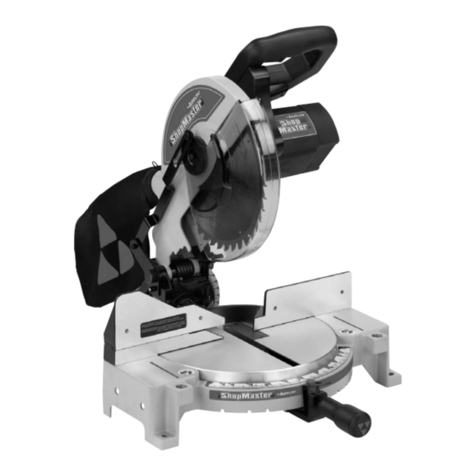
Delta
Delta 90513776 User manual
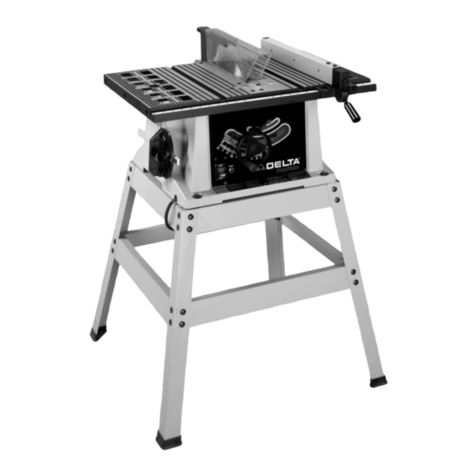
Delta
Delta ShopMaster TS200 User manual

Delta
Delta 36-714B User manual

Delta
Delta 36-550 User manual
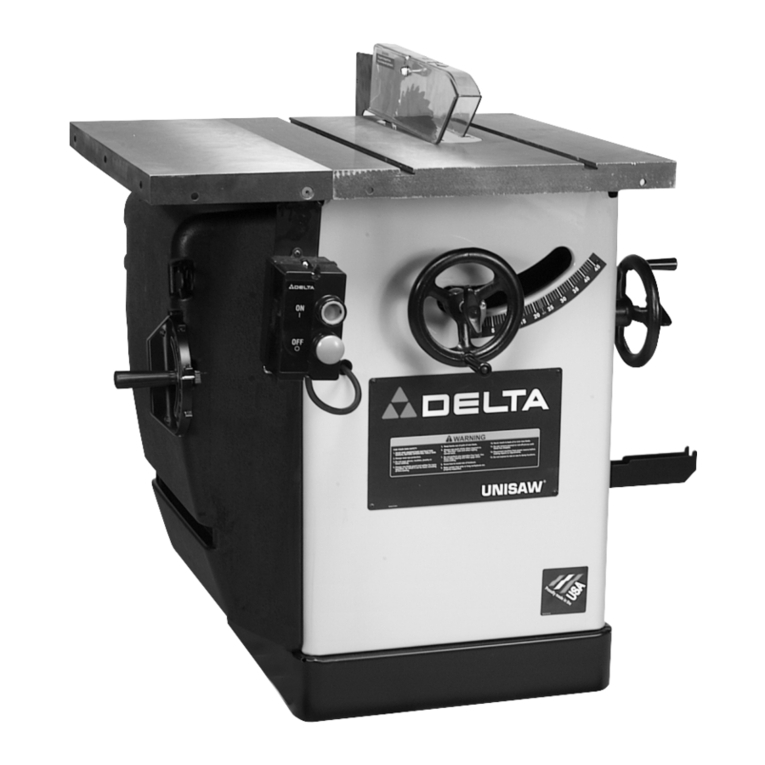
Delta
Delta UNISAW 36-953 User manual
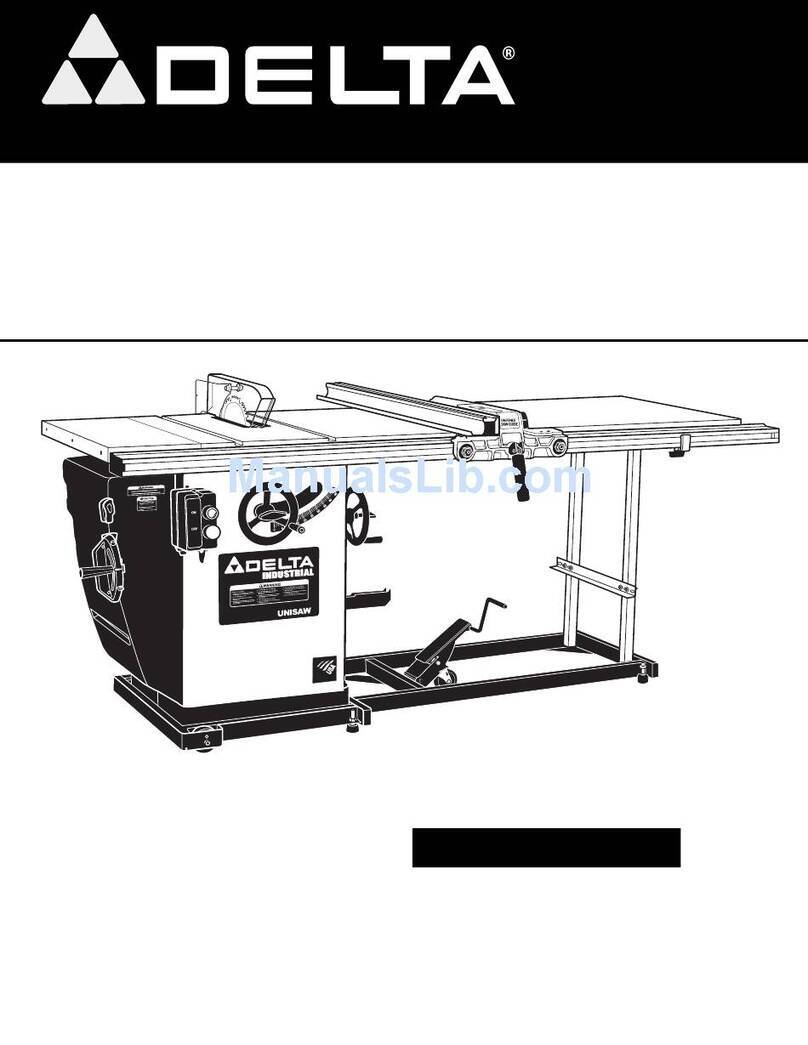
Delta
Delta UniSaw 36-L31 User manual
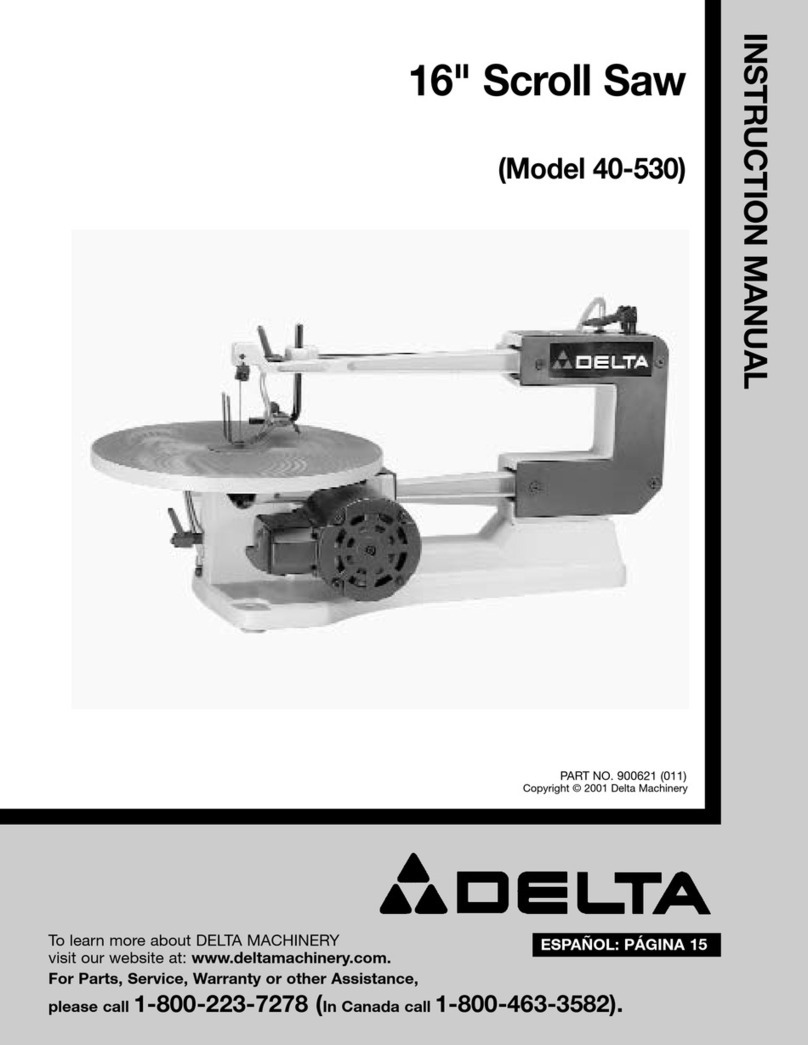
Delta
Delta 40-530 User manual
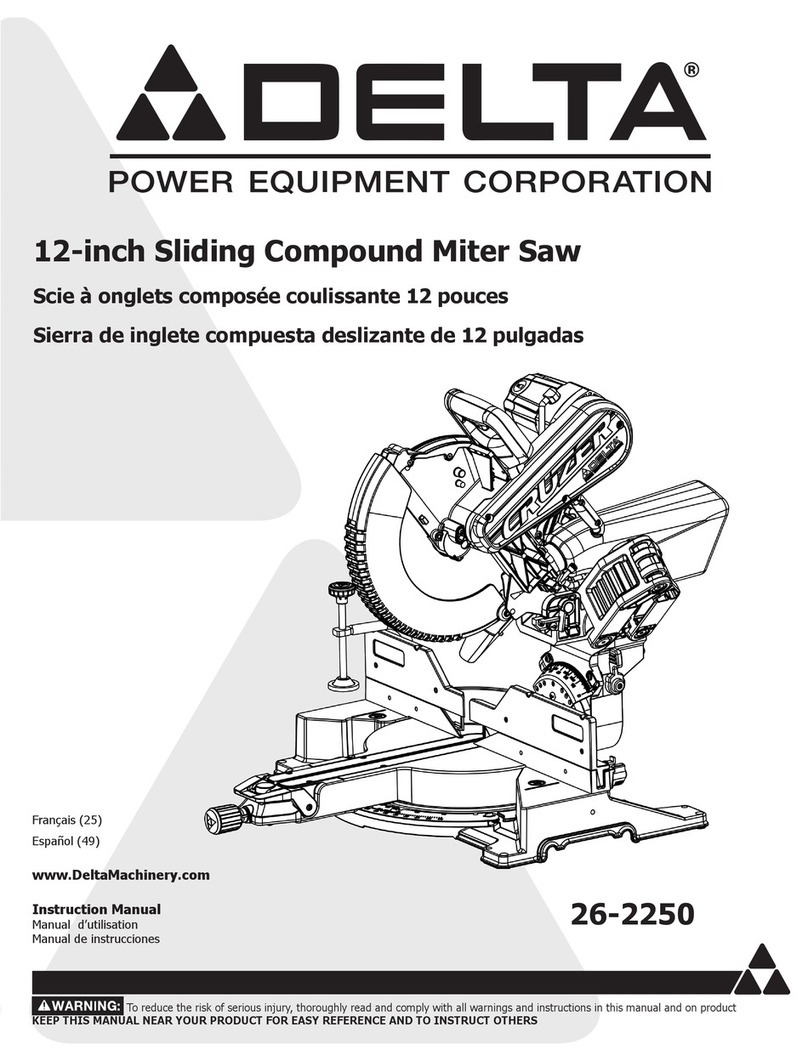
Delta
Delta 26-2250 User manual
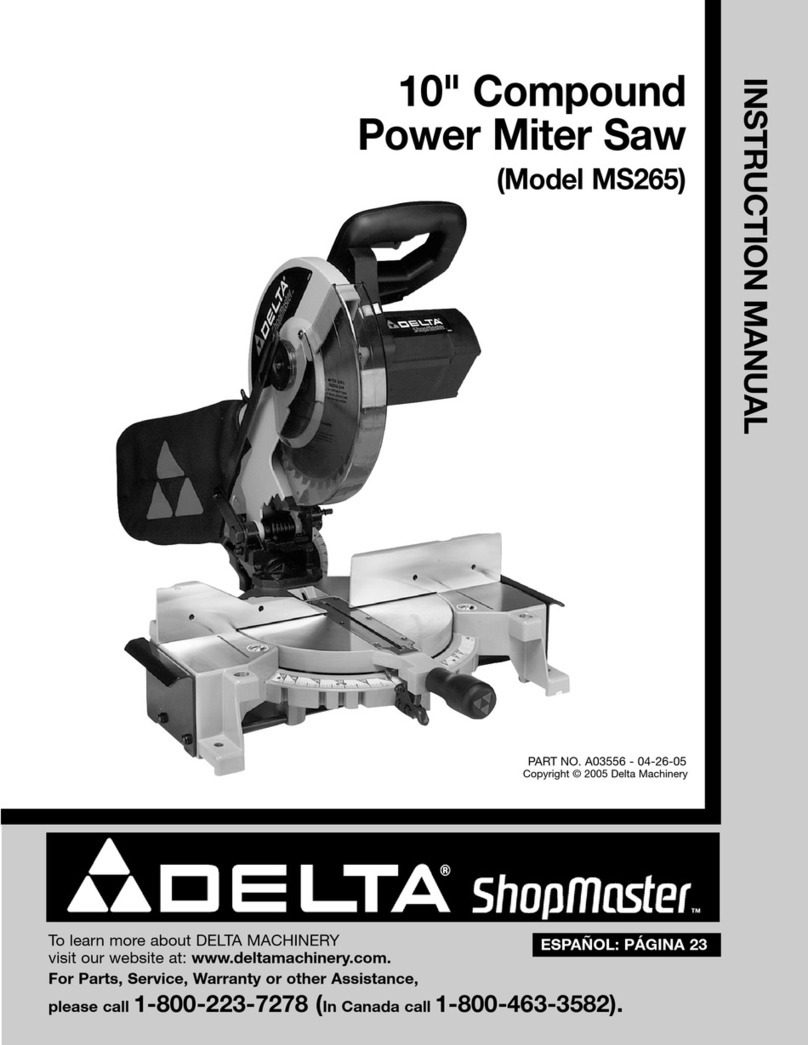
Delta
Delta ShopMaster MS265 User manual
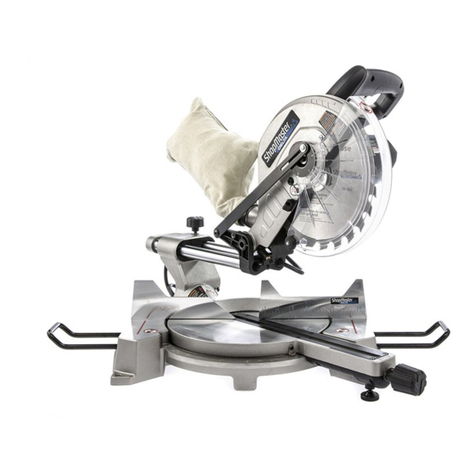
Delta
Delta ShopMaster S26-263L User manual
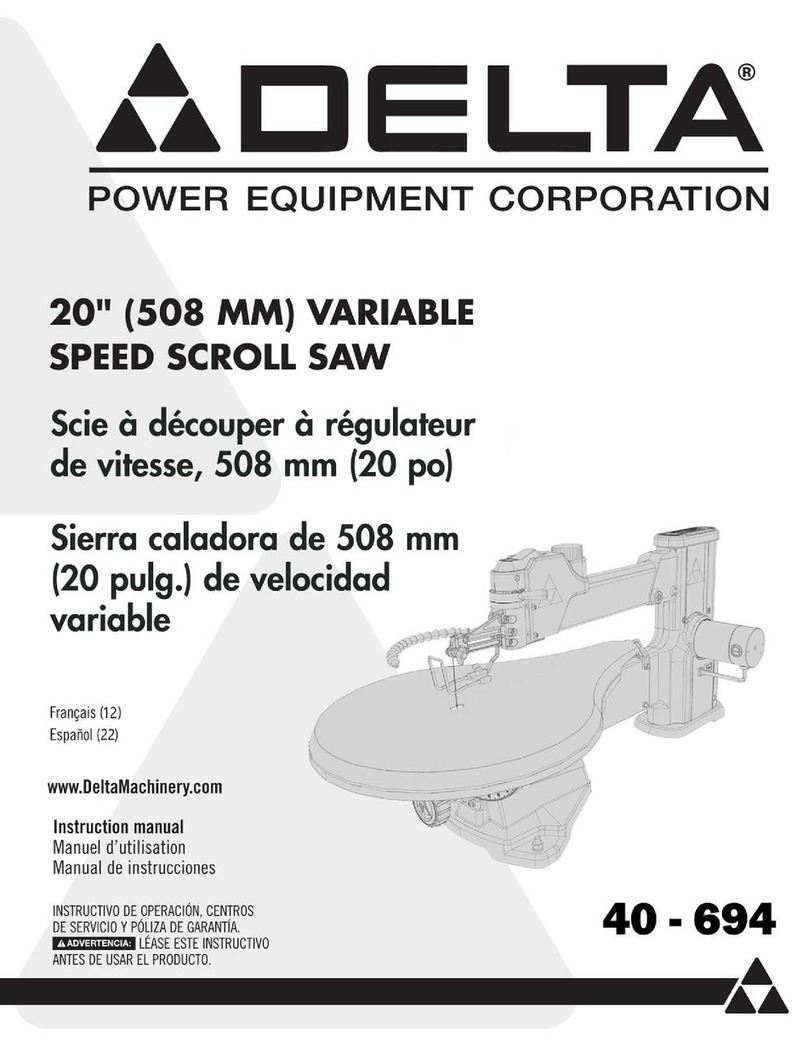
Delta
Delta 40-695 User manual
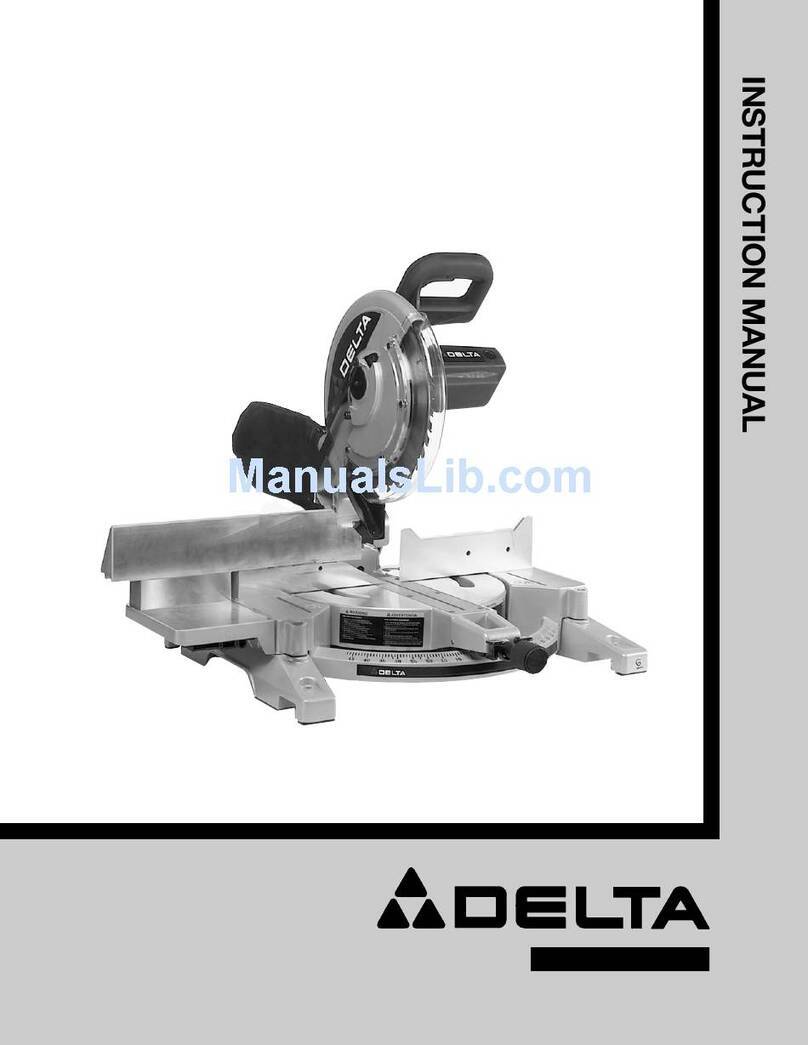
Delta
Delta 36-255 User manual
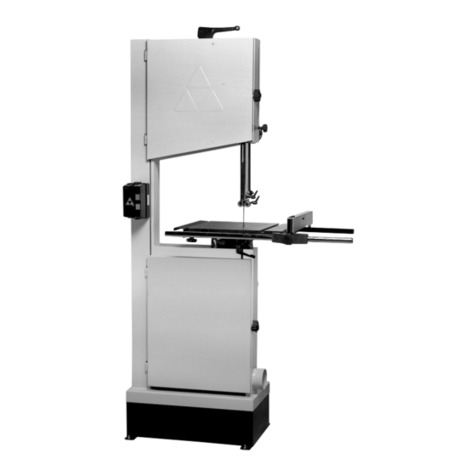
Delta
Delta 28-682 User manual

Delta
Delta 36-260 User manual

Delta
Delta ShopMaster BS100 User manual
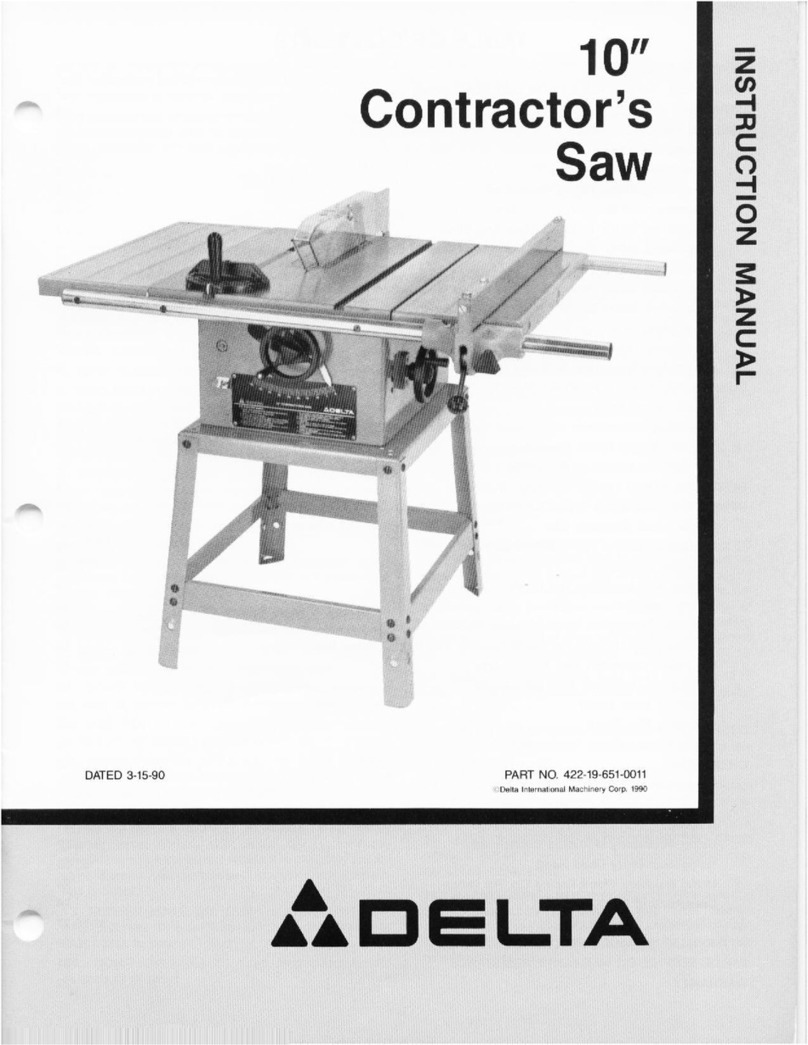
Delta
Delta 422-19-651-0011 User manual
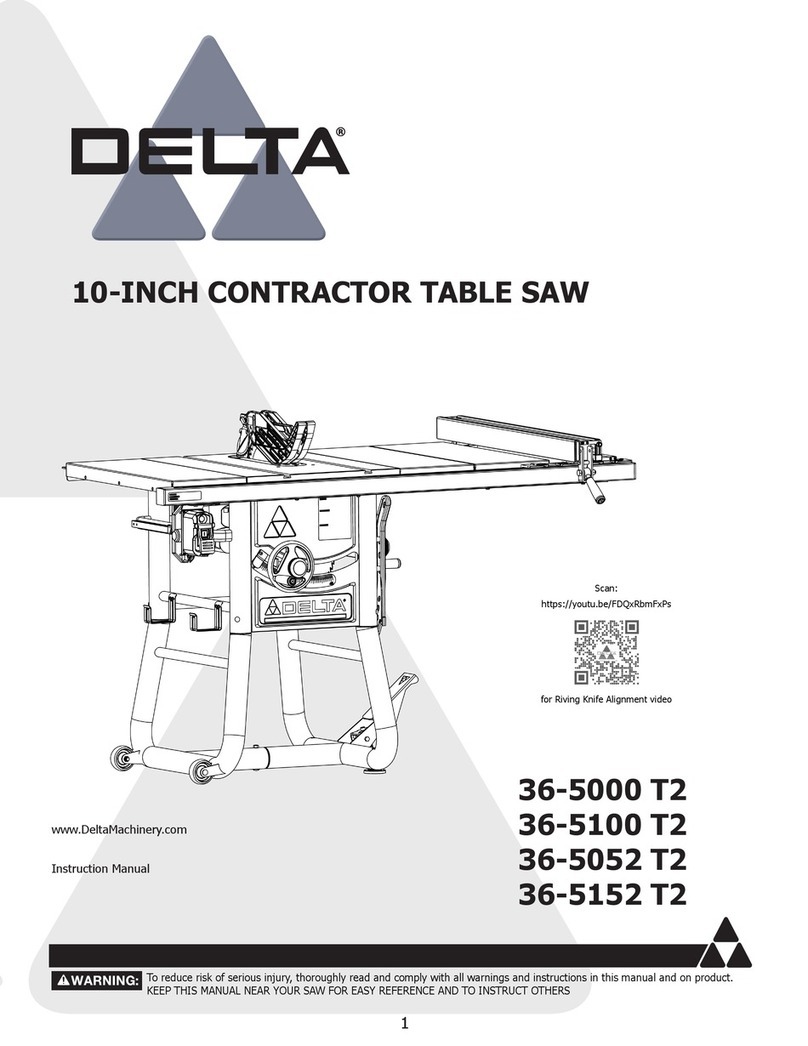
Delta
Delta 36-5100 T2 User manual
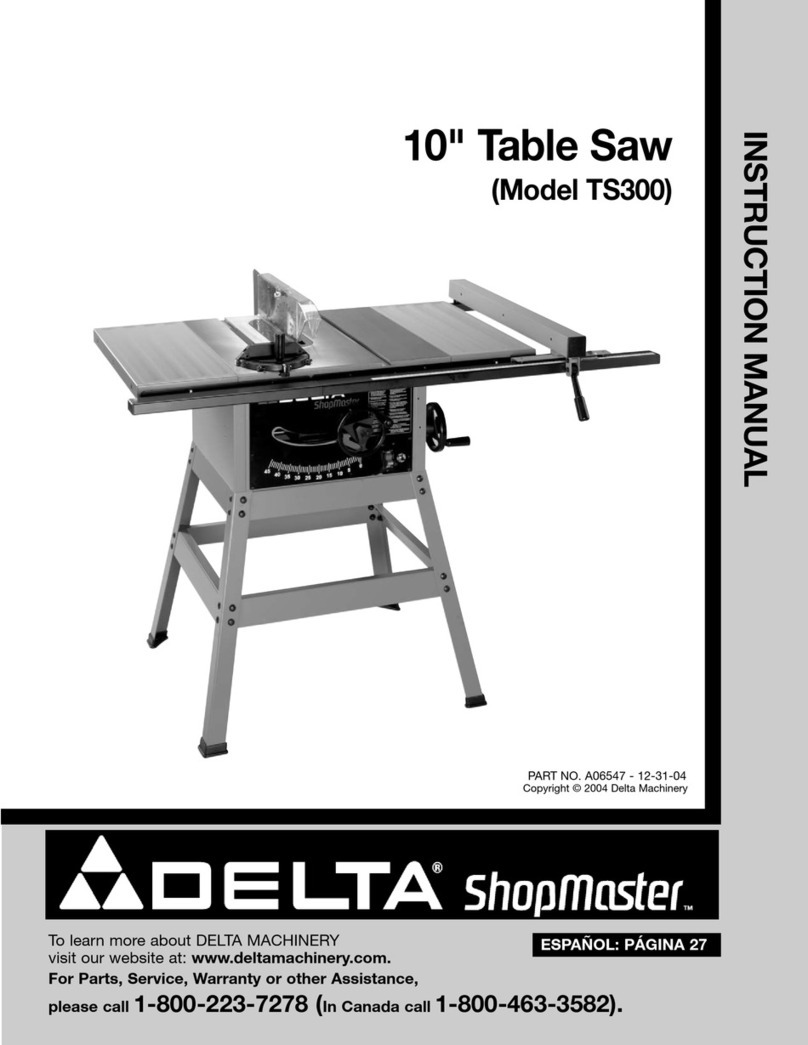
Delta
Delta ShopMaster TS300 User manual

Delta
Delta 28-150 User manual
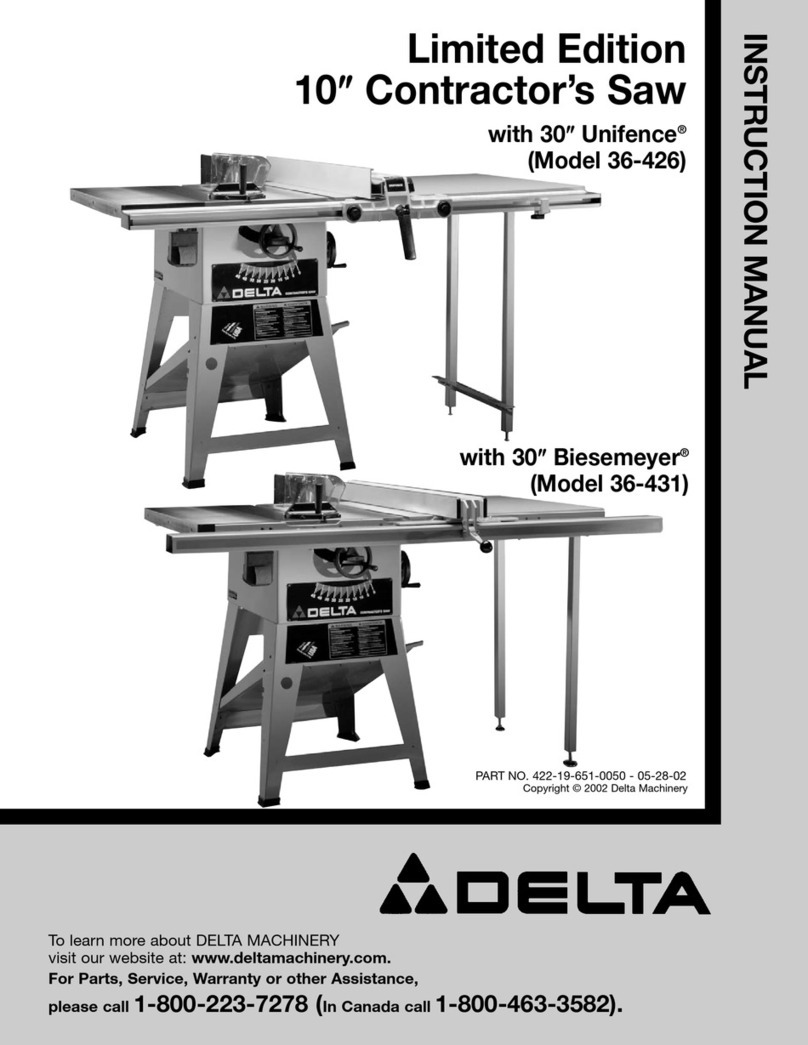
Delta
Delta 36-426 User manual
